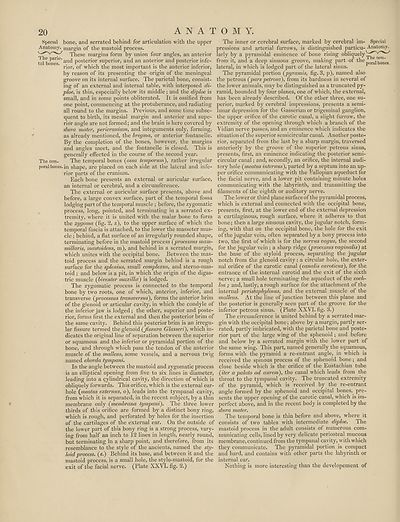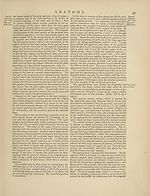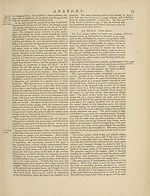Encyclopaedia Britannica > Volume 3, Anatomy-Astronomy
(28) Page 20
Download files
Complete book:
Individual page:
Thumbnail gallery: Grid view | List view

20 A N A T
Special bone, and serrated behind for articulation with the upper
Anatomy, margin of the mastoid process.
These margins form by union four angles, an anterior
t-'l bones6" and Poster>or superior, and an anterior and posterior infe¬
rior, of which the most important is the anterior inferior,
by reason of its presenting the origin of the meningeal
groove on its internal surface. The parietal bone, consist¬
ing of an external and internal table, with interposed di-
ploe, is thin, especially below its middle ; and the diploe is
small, and in some points obliterated. It is ossified from
one point, commencing at the protuberance, and radiating
all round to the margins. Previous, and some time subse¬
quent to birth, its mesial margin and anterior and supe¬
rior angle are not formed; and the brain is here covered by
dura mater, pericranium, and integuments only, forming,
as already mentioned, the bregma, or anterior fontanelle.
By the completion of the bones, however, the margins
and angles meet, and the fontanelle is closed. This is
generally effected in the course of the second year.
The tem- The temporal bones {ossa temporum), rather irregular
poral bones, in shape, are placed on each side at the lateral and infe¬
rior parts of the cranium.
Each bone presents an external or auricular surface,
an internal or cerebral, and a circumference.
The external or auricular surface presents, above and
before, a large convex surface, part of the temporal fossa
lodging part of the temporal muscle ; before, the zygomatic
process, long, pointed, and terminating in a serrated ex¬
tremity, where it is united with the malar bone to form
the zrjgoma (fig. 2, z), to the upper surface of which the
temporal fascia is attached, to the lower the masseter mus¬
cle ; behind, a flat surface of an irregularly rounded shape,
terminating before in the mastoid process (processus mam-
millaris, mastoideus, m), and behind in a serrated margin,
which unites with the occipital bone. Between the mas¬
toid process and the serrated margin behind is a rough
surface for the splenius, small complexus, and sterno-mas-
toid ; and below is a pit, in which the origin of the digas¬
tric muscle (biventer maxillae) is lodged.
The zygomatic process is connected to the temporal
bone by two roots, one of which, anterior, inferior, and
transverse (processus transversus), forms the anterior brim
of the glenoid or articular cavity, in which the condyle of
the inferior jaw is lodged; the other, superior and poste¬
rior, forms first the external and then the posterior brim of
the same cavity. Behind this posterior brim is an irregu¬
lar fissure termed the glenoid (Jissura Glasseri), which in¬
dicates the original line of separation between the superior
or squamous and the inferior or pyramidal portion of the
bone, and through which pass the tendon of the anterior
muscle of the malleus, some vessels, and a nervous twig
named chorda tympani.
In the angle between the mastoid and zygomatic process
is an elliptical opening from five to six lines in diameter,
leading into a cylindrical cavity, the direction of which is
obliquely forwards. This orifice, which is the external ear-
hole (^meatus externus, o), leads into the tympanal cavity,
from which it is separated, in the recent subject, by a thin
membrane only (membrana tympani). The three lower
thirds of this orifice are formed by a distinct bony ring,
which is rough, and perforated by holes for the insertion
of the cartilages of the external ear. On the outside of
the lower part of this bony ring is a strong process, vary¬
ing from half an inch to 12 lines in length, nearly round,
but terminating in a sharp point, and therefore, from its
resemblance to the style of the ancients, named the sty¬
loid process. (<f.) Behind its base, and between it and the
mastoid process, is a small hole, the stylo-mastoid, for the
exit of the facial nerve. (Plate XXVI. fig. 2.)
O M Y.
The inner or cerebral surface, marked by cerebral im- Special
pressions and arterial furrows, is distinguished particu- Anatomy-
larly by a pyramidal eminence of bone rising obliquely
from it, and a deep sinuous groove, making part of the bon'es
lateral, in which is lodged part of the lateral sinus.
The pyramidal portion (pyramis, fig. 3, p), named also
the petrous (pars petrosa), from its hardness in several of
the lower animals, may be distinguished as a truncated py¬
ramid, bounded by four planes, one of which, the external,
has been already described. Of the other three, one su¬
perior, marked by cerebral impressions, presents a semi¬
lunar depression for the Gasserian or trigeminal ganglion,
the upper orifice of the carotic canal, a slight furrow, the
extremity of the opening through which a branch of the
Vidian nerve passes, and an eminence which indicates the
situation of the superior semicircular canal. Another poste¬
rior, separated from the last by a sharp margin, traversed
anteriorly by the groove of the superior petrous sinus,
presents, first, an eminence indicating the posterior semi¬
circular canal; and, secondly, an orifice, the internal audi¬
tory hole (meatus internus), parted by a septum into an up¬
per orifice communicating with the Fallopian aqueduct for
the facial nerve, and a lower pit containing minute holes
communicating with the labyrinth, and transmitting the
filaments of the eighth or auditory nerve.
The lower or third plane surface of the pyramidal process,
which is external and connected with the occipital bone,
presents, first, at the lower end of the external depression
a cartilaginous, rough surface, where it adheres to that
bone; then a large sinuous cavity, the jugular notch, form¬
ing, with that on the occipital bone, the hole for the exit
of the jugular vein, often separated by a bony process into
two, the first of which is for the nervus vagus, the second
for the jugular vein ; a sharp ridge (processus vaginalis) at
the base of the styloid process, separating the jugular
notch from the glenoid cavity; a circular hole, the exter¬
nal orifice of the carotic canal (canalis caroticus), for the
entrance of the internal carotid and the exit of the sixth
nerve; a small hole terminating the aqueduct of the coch¬
lea ; and, lastly, a rough surface for the attachment of the
internal peristaphylinus, and the external muscle of the
malleus. At the line of junction between this plane and
the posterior is generally seen part of the groove for the
inferior petrous sinus. (Plate XXVI. fig. 3.)
The circumference is united behind by a serrated mar¬
gin with the occipital bone; above by a margin, partly ser¬
rated, partly imbricated, with the parietal bone and poste¬
rior part of the large wing of the sphenoid; and before
and below by a serrated margin with the lower part of
the same wing. This part, named generally the squamous,
forms with the pyramid a re-entrant angle, in which is
received the spinous process of the sphenoid bone; and
close beside which is the orifice of the Eustachian tube
(iter a palato ad aurem), the canal which leads from the
throat to the tympanal cavity. The truncated extremity
of the pyramid, which is received by the re-entrant
angle formed by the sphenoid and occipital bones, pre¬
sents the upper opening of the carotic canal, which is im¬
perfect above, and in the recent body is completed by the
dura mater.
The temporal bone is thin before and above, where it
consists of two tables with intermediate diploe. The
mastoid process in the adult consists of numerous com¬
municating cells, lined by very delicate periosteal mucous
membrane, continued from the tympanal cavity, with which
they communicate. The pyramidal portion is compact
and' hard, and contains with other parts the labyrinth or
internal ear.
Nothing is more interesting than the developement of
Special bone, and serrated behind for articulation with the upper
Anatomy, margin of the mastoid process.
These margins form by union four angles, an anterior
t-'l bones6" and Poster>or superior, and an anterior and posterior infe¬
rior, of which the most important is the anterior inferior,
by reason of its presenting the origin of the meningeal
groove on its internal surface. The parietal bone, consist¬
ing of an external and internal table, with interposed di-
ploe, is thin, especially below its middle ; and the diploe is
small, and in some points obliterated. It is ossified from
one point, commencing at the protuberance, and radiating
all round to the margins. Previous, and some time subse¬
quent to birth, its mesial margin and anterior and supe¬
rior angle are not formed; and the brain is here covered by
dura mater, pericranium, and integuments only, forming,
as already mentioned, the bregma, or anterior fontanelle.
By the completion of the bones, however, the margins
and angles meet, and the fontanelle is closed. This is
generally effected in the course of the second year.
The tem- The temporal bones {ossa temporum), rather irregular
poral bones, in shape, are placed on each side at the lateral and infe¬
rior parts of the cranium.
Each bone presents an external or auricular surface,
an internal or cerebral, and a circumference.
The external or auricular surface presents, above and
before, a large convex surface, part of the temporal fossa
lodging part of the temporal muscle ; before, the zygomatic
process, long, pointed, and terminating in a serrated ex¬
tremity, where it is united with the malar bone to form
the zrjgoma (fig. 2, z), to the upper surface of which the
temporal fascia is attached, to the lower the masseter mus¬
cle ; behind, a flat surface of an irregularly rounded shape,
terminating before in the mastoid process (processus mam-
millaris, mastoideus, m), and behind in a serrated margin,
which unites with the occipital bone. Between the mas¬
toid process and the serrated margin behind is a rough
surface for the splenius, small complexus, and sterno-mas-
toid ; and below is a pit, in which the origin of the digas¬
tric muscle (biventer maxillae) is lodged.
The zygomatic process is connected to the temporal
bone by two roots, one of which, anterior, inferior, and
transverse (processus transversus), forms the anterior brim
of the glenoid or articular cavity, in which the condyle of
the inferior jaw is lodged; the other, superior and poste¬
rior, forms first the external and then the posterior brim of
the same cavity. Behind this posterior brim is an irregu¬
lar fissure termed the glenoid (Jissura Glasseri), which in¬
dicates the original line of separation between the superior
or squamous and the inferior or pyramidal portion of the
bone, and through which pass the tendon of the anterior
muscle of the malleus, some vessels, and a nervous twig
named chorda tympani.
In the angle between the mastoid and zygomatic process
is an elliptical opening from five to six lines in diameter,
leading into a cylindrical cavity, the direction of which is
obliquely forwards. This orifice, which is the external ear-
hole (^meatus externus, o), leads into the tympanal cavity,
from which it is separated, in the recent subject, by a thin
membrane only (membrana tympani). The three lower
thirds of this orifice are formed by a distinct bony ring,
which is rough, and perforated by holes for the insertion
of the cartilages of the external ear. On the outside of
the lower part of this bony ring is a strong process, vary¬
ing from half an inch to 12 lines in length, nearly round,
but terminating in a sharp point, and therefore, from its
resemblance to the style of the ancients, named the sty¬
loid process. (<f.) Behind its base, and between it and the
mastoid process, is a small hole, the stylo-mastoid, for the
exit of the facial nerve. (Plate XXVI. fig. 2.)
O M Y.
The inner or cerebral surface, marked by cerebral im- Special
pressions and arterial furrows, is distinguished particu- Anatomy-
larly by a pyramidal eminence of bone rising obliquely
from it, and a deep sinuous groove, making part of the bon'es
lateral, in which is lodged part of the lateral sinus.
The pyramidal portion (pyramis, fig. 3, p), named also
the petrous (pars petrosa), from its hardness in several of
the lower animals, may be distinguished as a truncated py¬
ramid, bounded by four planes, one of which, the external,
has been already described. Of the other three, one su¬
perior, marked by cerebral impressions, presents a semi¬
lunar depression for the Gasserian or trigeminal ganglion,
the upper orifice of the carotic canal, a slight furrow, the
extremity of the opening through which a branch of the
Vidian nerve passes, and an eminence which indicates the
situation of the superior semicircular canal. Another poste¬
rior, separated from the last by a sharp margin, traversed
anteriorly by the groove of the superior petrous sinus,
presents, first, an eminence indicating the posterior semi¬
circular canal; and, secondly, an orifice, the internal audi¬
tory hole (meatus internus), parted by a septum into an up¬
per orifice communicating with the Fallopian aqueduct for
the facial nerve, and a lower pit containing minute holes
communicating with the labyrinth, and transmitting the
filaments of the eighth or auditory nerve.
The lower or third plane surface of the pyramidal process,
which is external and connected with the occipital bone,
presents, first, at the lower end of the external depression
a cartilaginous, rough surface, where it adheres to that
bone; then a large sinuous cavity, the jugular notch, form¬
ing, with that on the occipital bone, the hole for the exit
of the jugular vein, often separated by a bony process into
two, the first of which is for the nervus vagus, the second
for the jugular vein ; a sharp ridge (processus vaginalis) at
the base of the styloid process, separating the jugular
notch from the glenoid cavity; a circular hole, the exter¬
nal orifice of the carotic canal (canalis caroticus), for the
entrance of the internal carotid and the exit of the sixth
nerve; a small hole terminating the aqueduct of the coch¬
lea ; and, lastly, a rough surface for the attachment of the
internal peristaphylinus, and the external muscle of the
malleus. At the line of junction between this plane and
the posterior is generally seen part of the groove for the
inferior petrous sinus. (Plate XXVI. fig. 3.)
The circumference is united behind by a serrated mar¬
gin with the occipital bone; above by a margin, partly ser¬
rated, partly imbricated, with the parietal bone and poste¬
rior part of the large wing of the sphenoid; and before
and below by a serrated margin with the lower part of
the same wing. This part, named generally the squamous,
forms with the pyramid a re-entrant angle, in which is
received the spinous process of the sphenoid bone; and
close beside which is the orifice of the Eustachian tube
(iter a palato ad aurem), the canal which leads from the
throat to the tympanal cavity. The truncated extremity
of the pyramid, which is received by the re-entrant
angle formed by the sphenoid and occipital bones, pre¬
sents the upper opening of the carotic canal, which is im¬
perfect above, and in the recent body is completed by the
dura mater.
The temporal bone is thin before and above, where it
consists of two tables with intermediate diploe. The
mastoid process in the adult consists of numerous com¬
municating cells, lined by very delicate periosteal mucous
membrane, continued from the tympanal cavity, with which
they communicate. The pyramidal portion is compact
and' hard, and contains with other parts the labyrinth or
internal ear.
Nothing is more interesting than the developement of
Set display mode to:
![]() Universal Viewer |
Universal Viewer | ![]() Mirador |
Large image | Transcription
Mirador |
Large image | Transcription
Images and transcriptions on this page, including medium image downloads, may be used under the Creative Commons Attribution 4.0 International Licence unless otherwise stated. ![]()
| Encyclopaedia Britannica > Encyclopaedia Britannica > Volume 3, Anatomy-Astronomy > (28) Page 20 |
|---|
| Permanent URL | https://digital.nls.uk/193757712 |
|---|
| Attribution and copyright: |
|
|---|---|
| Shelfmark | EB.16 |
|---|---|
| Description | Ten editions of 'Encyclopaedia Britannica', issued from 1768-1903, in 231 volumes. Originally issued in 100 weekly parts (3 volumes) between 1768 and 1771 by publishers: Colin Macfarquhar and Andrew Bell (Edinburgh); editor: William Smellie: engraver: Andrew Bell. Expanded editions in the 19th century featured more volumes and contributions from leading experts in their fields. Managed and published in Edinburgh up to the 9th edition (25 volumes, from 1875-1889); the 10th edition (1902-1903) re-issued the 9th edition, with 11 supplementary volumes. |
|---|---|
| Additional NLS resources: |
|

